Email Marketing
Finding Success with SMS: Top 7 Marketing Campaigns from Ecommerce Brands
minute read

SMS marketing has created a lot of buzz lately in the marketing world.
SMS marketing (Short Message Service marketing) involves sending promotional messages over the phone via text message. It’s rapidly gained popularity over the last two years in the ecommerce space—and it’s easy to see why.
Nine out of ten consumers prefer to communicate with businesses through text message!
In a world where people spend over three hours a day on their phones, marketing with SMS is a no-brainer. But where should you begin?
With the basics, of course. Let’s get started.
The value of SMS marketing
SMS marketing is similar to email marketing in many ways. For example, they both offer the ability to personalize your messaging, gather data about your audience, and communicate directly with your subscribers.
But if they’re so similar, what’s the point of doing both?
While there are benefits to email marketing, SMS can offer value that email can’t. For example:
- Your message is more likely to be read. The email inbox is much more crowded than the SMS inbox. Since you’re competing with fewer senders in the SMS inbox, your message is more likely to stand out. Plus, while some people turn off their email notifications, most want to be notified when they receive a new text message so they can keep in touch with friends and family. This means there’s a good chance your message will not only be seen, but that it will be opened instantly.
- Two-way communication is quick and simple. SMS makes it easy to start a conversation with consumers. You can ask them about product preferences, get their opinion on their latest purchase, or find out what sort of messages they’d most like to receive from you.
- You don’t need internet. Good cell reception is all it takes to reach consumers.
Types of SMS campaigns
Another benefit of SMS is its versatility. With SMS, you can create campaigns for different purposes. Here are a few examples of the most common (and effective) types of SMS campaigns and tips on how to execute them:
1. Opt-in campaigns
The opt-in campaign is the first message your subscribers will see from you. When someone opts into your SMS program, they need to confirm their interest by replying to a text message from you.
Your text message should contain clear instructions for how to confirm their opt-in to make it as easy as possible for them to finish signing up. It should also mention the types of messages they can expect to receive from you (e.g., cart abandonment emails) so they know exactly what they’re signing up for.
In this example from Anthropologie, the message is quick, clear, and to the point—making it easy for subscribers to opt into SMS.
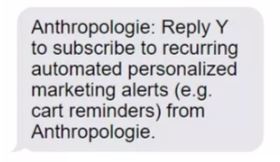
2. Welcome campaigns
A welcome campaign is the first message someone will receive after they confirm their opt-in.
Include any required information about messaging rates, a link to your privacy policy, message frequency, and clear instructions for how to unsubscribe if they want to stop receiving messages from you. This is also a good place to include a discount code or mention any other sign-up incentive.
Smart Furniture does all of this and more in their welcome message. They even ask subscribers to add them to their contacts under “Smart Furniture” so they’re not receiving texts from a random number. Smart move!
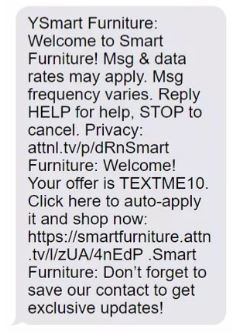
3. Abandoned cart campaigns
An abandoned cart campaign is a great way to encourage subscribers to finish their purchase. Mentioning free shipping or including a time-sensitive discount code can help incentivize subscribers to complete their purchase by creating a sense of urgency.
Bellami Hair, for example, entices subscribers to revisit their carts by offering five percent off if they make a purchase within 72 hours.
Just keep in mind many SMS tools limit the number of messages you can send to one per cart, or one within a certain time period. They also tend to require you to send this type of message within 48 hours after the shopper has left your online store.
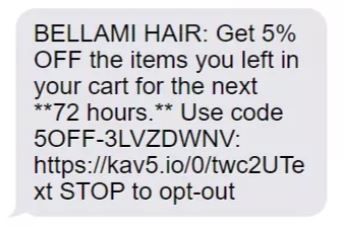
4. Product launch campaigns
Have a new product you can’t wait to introduce? SMS is the perfect place to announce it—especially if it’s been long-awaited. Since people tend to see their text messages before they check their email, they’ll have a better chance of buying the product before it sells out.
In this example from Glamlite, the campaign piques interest by highlighting a specific product in their new collection (first 30 color palette) and creates urgency by telling subscribers to “Shop now before it’s gone!”
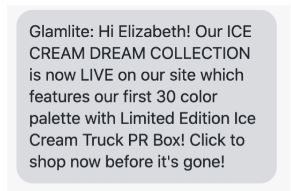
5. Promotional campaigns
Whether it’s a holiday clearance event, flash sale, or a discount on a specific product, SMS is the way to go if you want subscribers to know about a promotion you’re running.
In this example from Stila, they promote their liquid eyeliner with a “buy one get one free” sale.
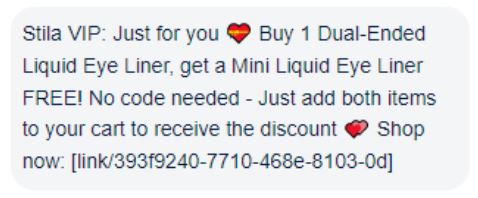
6. Birthday campaigns
Who doesn’t love receiving messages on their birthday? Birthday campaigns are a great way to connect with subscribers, make them feel special, and show them you care—all of which build customer loyalty.
The best birthday campaigns usually offer a discount code, like in the example below from Body Candy. And if you really want to stand out, consider offering subscribers a free gift!

7. Rewards program campaigns
If you have a loyalty program, use SMS to encourage signups, keep members informed on their status, and bring subscribers up to speed on special members-only promotions and events.
Plant People encourages signups by telling subscribers they can earn “double the points” if they join their loyalty program by a certain date.
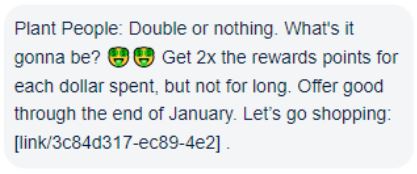
Tips for creating successful SMS campaigns
No matter what type of SMS marketing campaign you choose to create, it’s important to keep the following tips in mind to increase your chances of success.
Follow all rules and regulations
Before sending your first SMS campaign, make sure you know about the regulations governing SMS and understand the limits your mobile phone provider may have. Many SMS marketing platforms have built-in compliance information and offer guidance on how to create campaigns that follow these rules.
Keep messages short
Try to keep content short, within the 160-character limit of one SMS. Many mobile phone providers still charge people to receive commercial text messages. Sending more than one text message at a time will upset your subscribers.
Don’t be overbearing
When it comes to SMS, a little goes a long way. Sending too many messages within a small window of time can annoy subscribers and cause them to leave you in the long run. To avoid this, consider establishing a set window of time (e.g., 12am – 7am) during which you will not message subscribers.
Personalize campaigns
Subscribers will respond more positively to your messages when the campaign is tailored to them and their interests. Personalize your messages when possible by addressing the subscriber by name or promoting products you think they’d enjoy based on their past purchases.
Don’t stress over SMS
Entering a new area of marketing can be scary. But with proper guidance and the right inspiration, anything is possible. Taking advantage of these tips and tricks is a great first step towards mastering SMS.
Looking for more SMS examples? MailCharts, from Validity, can provide the campaign inspiration you need. MailCharts includes a library of SMS examples from leading brands to power data-driven SMS campaign planning for ecommerce marketing teams.
Join MailCharts for free now to see unlocked SMS inspiration from leading ecommerce brands.